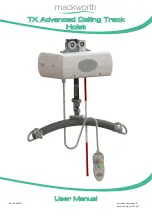
18
EKZT-Series | Version 1.03
Troubleshooting
10 Troubleshooting
11 Disposal, recycling of used devices
Please take care in your own interest and in the interest
of the environment that all component parts of the ma-
chine are only disposed of in the intended and permit-ted
way.
11.1 Decommissioning
Immediately decommission used machines in order to
avoid later misuse and endangering of the envi-ronment
or of persons.
Step 1: Eliminate all environmentally hazardous operat-
ing materials from the used device.
Step 2: If required, disassemble the machine into easy-
to-handle and usable components and parts.
Step 3: Dispose of machine components and operating
materials by the disposal channels provided.
11.2 Disposal of lubricants
Remove any leaking, used or excessive grease at the lu-
bricating points.
Disposal notes for used lubricants are available from the
manufacturer of the lubricants. If necessary, request the
productspecific data sheets.
Faults
Possible cause
Solution
Chain hoist motor is not functioning.
1.Inadequate power supply.
2.Wrong phase conductor
3.Switch defective.
4.Rectifier defective
5.Transformer defective
6.Motor defective.
1.Check power supply.
2.Change phase.
3.Replace switch
4.Replace rectifier.
5.Replace transformer.
6.Change motor.
Motor restarts after function key is re-
leased.
Switch defective.
Replace switch
Temperature of motor too high
Workload too great.
Reduce load.
Runs on too long after switch-off.
1.Oily brake disc.
2.Worn brake disc.
3.Compression spring defective.
4.Overload.
1.Clean brake disc.
2.Replace brake disc.
3.Replace compression spring.
4.Reduce load.
Unusual noises.
1.Chain dry or very worn.
2.Gear wheels very worn..
1.Lubricate or replace chain.
2.Replace gear wheels.
Upper and lower limit switches not
functioning.
1.Poor connection.
2.Limit switch defective.
1.Check connection
2.Replace limit switch.
Leakage current
1.Poor or no earthing.
2.Interior cables are in contact with
the casing.
3.Humidity too high.
4.Live components dirty.
1.Check earthing and/or restore
connection.
2.Check wiring.
3.Avoid operation in a very humid at-
mosphere.
4.Keep equipment clean.































